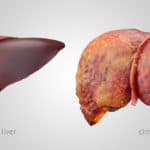Urgent Reason for Hep C Patients to Get Lean!
New research published in two different respected medical journals demonstrates that those with Hepatitis C who also have a high body mass index (BMI) are at an especially elevated risk of developing primary liver cancer. A brief analysis of these conclusions clearly points to maintaining a healthy weight as an essential preventative measure to prevent liver cancer development.
Due to improvements in Hepatitis C drug therapy, an increasing number of people infected with this virus are able to successfully defeat it. However, whether previous non-responders, those ineligible for therapy or people who choose to wait for better treatment in the future, persons living with Hepatitis C are left to try and prevent the advancement of liver disease. In particular, affected individuals aim to keep their liver as healthy as possible so that cirrhosis or primary liver cancer does not develop.
About Primary Liver Cancer
Primary liver cancer is cancer that begins in the liver cells. Liver cancer occurs when liver cells develop changes (mutations) in their DNA. The mutations cause a change in the DNA’s instructions that could result in cells growing out of control and eventually form a cancerous tumor.
Although the cause of primary liver cancer is not always known, there are several factors that increase liver cancer risk. Some of the greatest potential liver cancer risks include:
- Chronic Hepatitis B or Hepatitis C infection
- Diabetes
- Nonalcoholic fatty liver disease (NAFLD)
- Alcoholism
- Cirrhosis
- Obesity (high body mass index)
All of the risk factors listed above are known to cause liver cell inflammation and injury, rendering the affected cells most susceptible to cancerous mutations.
About Body Mass Index
Using a person’s weight and height, body mass index (BMI) is a calculated number that provides a fairly reliable indicator of body fat percentage. Traditionally, BMI is used to screen for obesity. If someone is found to have a high BMI, a healthcare provider would need to perform further assessments (such as skin fold thickness measurements, evaluations of diet, physical activity, family history and other appropriate health screenings) to determine a person’s health risks.
When calculating with measurements in pounds and inches, the BMI formula is calculated by dividing a person’s weight in pounds (lbs) by height in inches (in) squared – and then multiplying by a conversion factor of 703.
For adults, BMI ranges are associated with the following weight classifications:
- Underweight – BMI under 18.5
- Normal weight – BMI between 18.5 and 24.9
- Overweight – BMI between 25 and 29.9
- Obese – BMI of 30 and above
Although BMI is a useful tool, it is important to remember that this is a calculation and not an actual representation of body fat. Due to variances in genetics, body composition and density, a person with an overweight BMI may not have much body fat.
Studies on Liver Cancer and BMI
Although Hepatitis C and a high BMI are both known risks for primary liver cancer, two quantitative assessment studies from China shine some additional light on this risk.
- As published in a September 2012 edition of the journal, The Oncologist, researchers examined the relative risk of BMI and hepatitis infection on primary liver cancer risk. They found that while those with Hepatitis C, cirrhosis and a BMI over 32 were at pronounced risk of developing primary liver cancer, those with Hepatitis C or cirrhosis AND a BMI over 32 were at a far greater risk.
- As published in a September 2012 edition of The European Journal of Cancer, researchers did a meta-analysis of observational studies involving excess body weight and primary liver cancer risk. They found that obesity (a BMI of 30 and above) in males was the greatest risk factor for developing primary liver cancer. Their analysis revealed that obesity represented the greatest risk factor independent of Hepatitis C infection.
Transforming obesity into a healthful weight is no small task, but it appears to be the number one way to reduce the likelihood of developing primary liver cancer. Because people with a high BMI who have been unable to rid their bodies of the Hepatitis C virus are at an especially elevated liver cancer risk, dedication to losing excess body fat should be the foremost priority of every hepatologist and patient.
References:
http://www.cdc.gov/healthyweight/assessing/bmi/adult_bmi/index.html, About BMI for Adults, Retrieved September 9, 2012, Centers for Disease Control and Prevention, 2012.
http://www.mayoclinic.com/health/liver-cancer/DS00399/, Liver Cancer, Retrieved September 9, 2012, Mayo Foundation for Medical Education and Research, 2012.
http://www.mskcc.org/cancer-care/adult/liver/risk-factors-prevention, Liver Cancer: Risk Factors & Prevention, Retrieved September 9, 2012, Memorial Sloan-Kettering Cancer Center, 2012.
http://www.ncbi.nlm.nih.gov/pubmed/22446023, Excess body weight and the risk of primary liver cancer: An updated meta-analysis of prospective studies, Chen Y, et al, Retrieved September 9, 2012, The European Journal of Cancer, September 2012.
http://www.ncbi.nlm.nih.gov/pubmed/22956536, Body Mass Index and Risk of Primary Liver Cancer: A Meta-Analysis of Prospective Studies, Wang Y, et al, Retrieved September 9, 2012, The Oncologist, September 2012.
http://www.oncentral.org/news/2012/04/23/study-obesity-and-liver-cancer-linked/, Study: Obesity and Liver Cancer Linked, Jose Martinez, Retrieved September 9, 2012, Southern California Public Radio, 2012.







